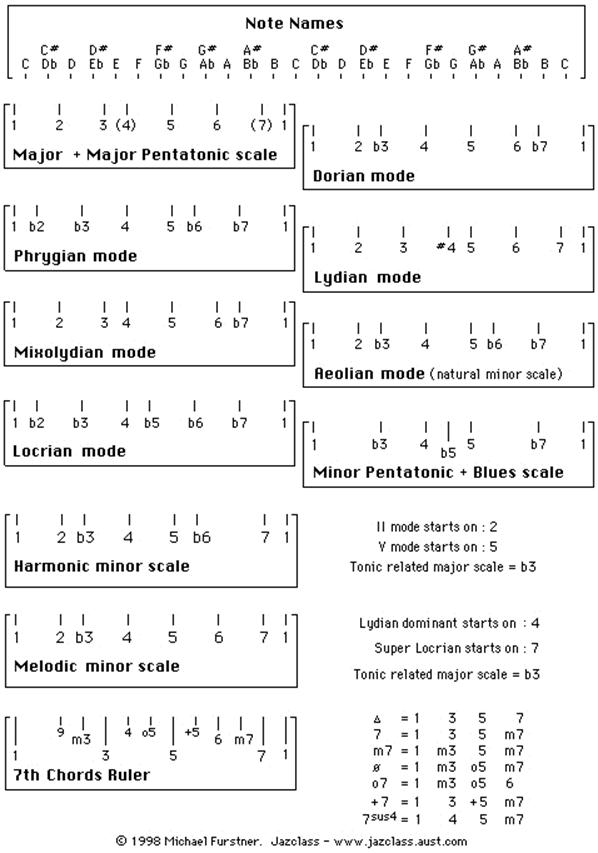In Scales, Theorie on January 6, 2010 at 10:23 am
A minor scale can be defined as any scale with a minor scale-tone tonic chordbut without a major 3rd (measured from the scale tonic). The scale must contain:
- a minor 3rd
- a perfect 5th
The minor pentatonic scale and the blues scale are minor scales, but the 8-note dominant scale is not : it contains an ambiguous major 3rd. Neither is the 8-note diminished scale because a minor scale-tone chord cannot be formed on its tonic note (it lacks a perfect 5th).
They are (in order of their importance in Jazz):
-
Dorian mode – characteristic notes : 6 and b7
-
Harmonic minor scale – characteristic notes : b6 and 7
-
Aeolian mode (natural minor scale) – characteristic notes : b6 and b7
-
Melodic minor scale – characteristic notes : 6 and 7
-
Phrygian mode – characteristic notes : b2, b6 and b7
These minor scales are easiest to recognise by ear by knowing their tetrachord components.
The four component tetrachords are:
Uses of the minor scales
Below a brief overview of the most common uses for the various minor scales in Jazz improvisation.
1. Dorian mode
This is by far the most commonly used minor scale for Jazz improvisation. Use the Dorian mode over minor chords in these settings.
-
for isolated minor 7th chords : Cm7
-
in all IIm7 – V7 segments : Cm7 – F7
-
when preceded by V7 : G7 – Cm7 or Dø – G7 – Cm7
-
when preceded by 1 or 2 other minor chords : (Dm7 -) Gm7 – Cm7
(in this case Cm7 is part of a scale-tone chord progression segment of a major scale)
2. Harmonic minor
This scale is never used over minor 7th chords and only occasionally over minor triads.Use this scale over al IIø – V7 segments in songs.
In the segment Gø – C7 use :
G – Ab – Bb – C – Db – E – F – G (IImode F harmonic minor) over Gø (IIø)
C – Db – E – F – G – Ab – Bb – C (Vmode F harmonic minor) over C7 (V7)
Use the V mode of the harmonic scale over all V7 chords in typically minor songs.
3. Aeolian mode (natural minor scale)
This scale is most commonly used when there are 2 minor 7th chords (which are next to one another on the Circle of Fifths). They then represent two scale-tone chords of a major scale like VIm7 and IIm7, or of a minor scale like Im7 – IVm7.
Use the Dorian mode for the minor 7th chord down stream on the Circle of Fifths.
Use the Aeolian mode for the upstream m7 chord.
Both modes use the same scale tones.
For example for a combination of Cm7 and Fm7 chords use :
C – D – Eb – F – G – Ab – Bb – C (C Aeolian mode) : for Cm7 (VIm7)
F – G – Ab – Bb – C – D – Eb – F (F Dorian mode) : for Fm7 (IIm7)
(Sometimes the C Dorian mode is still preferred over Cm7 to create some additional interest.)
4. Melodic minor
This scale is rarely used for improvisation over minor chords.Its great attraction in Jazz are the modes derived from the melodic minor scale. These are commonly used for altered dominant chords.
5. Phrygian mode
This mode is very prominent in the composition and improvisation over Spanish flamenco music. In Jazz the Phrygian mode is mainly used for scale-tone chord segments that contain three minor 7th chords. They function as : IIIm7 – VIm7 – IIm7. The Phrygian mode is use for the first chord in the row (IIIm7)
In the segment Gm7 – Cm7 – Fm7 use :
G – Ab – Bb – C – D – Eb – F – G (G Phrygian mode) : for Gm7 (IIIm7)
C – D – Eb – F – G – Ab – Bb – C (C Aeolian mode) : for Cm7 (VIm7)
F – G – Ab – Bb – C – D – Eb – F (F Dorian mode) : for Fm7 (IIm7)
Note that all three modes contain the same notes because they are derived from the same major scale. When in doubt as to what scale to use, try out different ones and listen to it.
The ImM7 Chord
Progression: Im – ImM7 – Im7 – VIø – bVImaj7 – V7
The minor Major 7th chord is the scale-tone 7th chord built on the tonic of the harmonic minor scale (and also of the melodic minor scale).
Its main use is as a passing chord between a minor triad and a minor 7th chord.
This chord sequence produces a stepwise (semitone) motion from C –> B –> Bb
-
Cm = C – Eb – G – C
-
CmM7 = C – Eb – G – B
-
Cm7 = C – Eb – G – Bb
The chords produce a continuous line of chord tones that descends stepwise in semitones through the entire progression.
In C minor : C –> B –> Bb –> A –> Ab –> G –> then back to C
This line is most commonly used as a moving bass line
—
Source: JazClass from Michael Furstner, who developed a very comprehensive Jazz Class course. Thanks to him.
for print Five minor 7 scales





